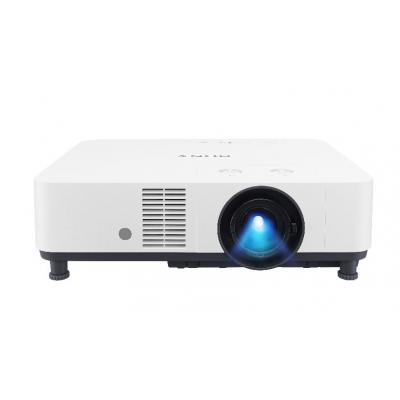Choosing a data projector for any use case is relatively simple; all you need to do is determine the ‘throw’ and resolution you require. These elements dictate the projector’s distance from the screen and the image quality.
Determine throw
The ‘throw’ of a projector determines the image size when set at a distance. In other words, it tells us how big an image will be from a certain distance away.
‘Throw’ is designated with the following example: 1.5:1. This means that for every 1 foot of image width, the projector must be moved 1.5 feet away.
You will come across three types of throw:
- Regular throw (1.5:1 +)
- Short throw (0.38:1 – 1.4:1)
- Ultra-short throw (0.37:1 or less)
The correct throw for your space depends on where your projector will live in respect to the screen. A shorter throw means the data projector is located closer to the screen, and Ultra-short throw models can live less than a foot away.
Determine resolution
Projector resolution determines image quality with how many pixels it can display on a screen. A higher resolution means a crisper image, but it also means a higher cost, so you need to strike a balance if you are on a budget.
Here are the main resolutions:
- XGA (1024 x 768)
- 720p (1280 x 720)
- 1080p (1920 x 1080)
- 4K (3840 X 2160)
- WUXGA (1920 X 1200)
XGA and 720p are suitable for smaller screens because the smaller the screen, the less space the pixels have to fill. If you want to fill a large screen, say over 60”, you should opt for WUXGA at a minimum and maybe even 4K.
Other factors to consider
Here are a few more things to look for:
Lumens
Lumens is a measurement of image brightness — the higher the lumens, the brighter the image can be. Brighter images are beneficial in classrooms and boardrooms because they negate the need to draw curtains.
Anything under 2,000 lumens is too dim for educational and business use, for which you want at least 3,000 lumens. The brightest projectors exceed 8,000 lumens, although this is very bright and might be overkill for your room.
Contrast ratio
We’ll keep this simple – data projectors need a contrast ratio of at least 1,000:1 if you want to display dynamic images with rich blacks and tones. The higher the contrast ratio, the better the detail and quality of the projected image.
Anything between 1,500:1 and 2,000:1 is considered excellent, but 1,000:1 will do for most classrooms, boardrooms and retail settings.
Brands
The market is flooded with data projectors from brands that rebadge cheap units from China and sell them for a tidy profit. You are best off sticking to well-known brands in the industry, like Hitachi, Sony and NEC.
Here’s a list of the brands we recommend:
- Casio
- Maxell
- Hitachi
- Vivitek
- BenQ
- NEC
- Epson
- Sony
- Panasonic
- Viewsonic
Any questions? Feel free to contact us. We’re happy to recommend projectors for your use case with full installation services.



